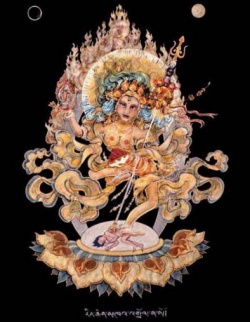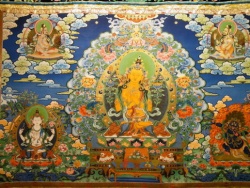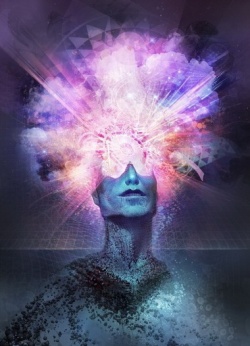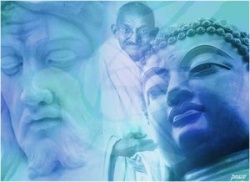Difference between revisions of "Two truths"
| (8 intermediate revisions by 2 users not shown) | |||
| Line 1: | Line 1: | ||
| + | {{DisplayImages|678|177|391|1790}} | ||
| + | [[Two truths]] (Skt. ''[[dvasatya]]''; Tib. {{BigTibetan|[[བདེན་པ་གཉིས་]]}}, [[Wyl.]] ''[[bden pa gnyis]]'') — everything has an [[absolute]] aspect, or [[absolute truth]], and a [[relative]] aspect, or [[relative truth]]. The [[absolute]] or [[Wikipedia:Absolute (philosophy)|ultimate]] is the [[inherent]] [[nature]] of everything, how things really are. The [[Wikipedia:Convention (norm)|conventional]] or [[relative]] is how things appear. In the teachings, these are known as ‘the [[two truths]]’, but they are not to be understood as two separate {{Wiki|dimensions}}, rather as two aspects of a single [[reality]]. [[two truths]] ([[satyadvaya]], [[dvisatya]], [[den pa gnyi]]): The [[relative truth]] that is the [[world]] as we normally [[experience]] it and the [[Wikipedia:Absolute (philosophy)|ultimate]] or [[absolute truth]]. | ||
| − | + | See also; “[[conventional wisdom]]” And “[[ultimate truth]].” | |
==From the [[Sutras]]== | ==From the [[Sutras]]== | ||
| − | {{: | + | |
| + | {{tibquote|འཇིག་རྟེན་མཁྱེན་པས་བདེན་པ་འདི་གཉིས་ཏེ། །<br /> | ||
| + | ཁྱེད་ཀྱིས་གཞན་ལས་མ་གསན་རང་གིས་རིག །<br /> | ||
| + | དེ་ནི་ཀུན་རྫོབ་བདེན་དང་དོན་དམ་སྟེ། །<br /> | ||
| + | བདེན་པ་གསུམ་པ་གང་ཡང་མ་མཆིས་སོ། །<br />}} | ||
| + | |||
| + | You, the [[knower of the world]],<br /> | ||
| + | [[Realized]] the two levels of [[reality]],<br /> | ||
| + | By yourself, not studying them from others.<br /> | ||
| + | They are the [[relative]] and the [[Wikipedia:Absolute (philosophy)|ultimate]].<br /> | ||
| + | There is not some third level of [[reality]].<br /> | ||
| + | :::''[[Buddha Shakyamuni|Śākyamuni]]'', ''[[Sūtra]] of the Meeting of Father and Son'' | ||
| + | |||
| + | |||
==The [[Two Truths]] According to the [[Four tenet systems|Four Schools]]== | ==The [[Two Truths]] According to the [[Four tenet systems|Four Schools]]== | ||
| Line 19: | Line 34: | ||
::''[[Treasury of Abhidharma]]'', VI, 4<br> | ::''[[Treasury of Abhidharma]]'', VI, 4<br> | ||
| − | :As this says, any coarse thing which can be smashed to pieces with a hammer or dissected into parts by the [[mind]], so that the [[mind]] which apprehended that coarse [[appearance]] no longer identifies it as such, belongs to the | + | :As this says, any coarse thing which can be smashed to pieces with a hammer or dissected into parts by the [[mind]], so that the [[mind]] which apprehended that coarse [[appearance]] no longer identifies it as such, belongs to the [[relative truth]] . Then concerning the [[absolute]], any coarse material thing or [[state of consciousness]] can be broken down into its [[Wikipedia:Absolute (philosophy)|ultimate]] constituents, which are {{Wiki|individual}} {{Wiki|particles}} or moments. Therefore the [[partless particle]]s, which are the [[Wikipedia:Absolute (philosophy)|ultimate]] constituents of coarser things, and the [[indivisible moments of consciousness]], which are the [[Wikipedia:Absolute (philosophy)|ultimate]] constituents of [[mental phenomena]], are said to be '''[[absolute truth]]'''. |
===The [[Sautrantika]] [[View]]=== | ===The [[Sautrantika]] [[View]]=== | ||
[[Khenpo Ngakchung]] says: | [[Khenpo Ngakchung]] says: | ||
| − | :Then, if we consider the [[Sautrantikas]], it says in the ''[[Commentary on Valid Cognition]]''<ref>{{: | + | :Then, if we consider the [[Sautrantikas]], it says in the ''[[Commentary on Valid Cognition]]''<ref>{{tibquote|དོན་དམ་དོན་བྱེད་ནུས་པ་གང༌། །<br /> |
| + | དེ་འདིར་དོན་དམ་ཡོད་པ་ཡིན། །<br /> | ||
| + | གཞན་ནི་ཀུན་རྫོབ་ཡོད་པ་སྟེ། །<br />}} | ||
| + | That which can ultimately perform a [[function]]<br /> | ||
| + | Is here said to be ultimately [[existent]].<br /> | ||
| + | All else besides has [[relative]] [[existence]].<br /> | ||
| + | :::''[[Dharmakirti|Dharmakīrti]]'', ''[[Commentary on Valid Cognition]]'', [[chapter]] III, 3</ref>: | ||
::"That which can perform a [[function]]<br> | ::"That which can perform a [[function]]<br> | ||
| Line 30: | Line 51: | ||
::All that can not perform a [[function]]<br> | ::All that can not perform a [[function]]<br> | ||
::Is said to be relatively [[existent]].<br> | ::Is said to be relatively [[existent]].<br> | ||
| − | ::These are specific and | + | ::These are specific and general {{Wiki|characteristics}}."<br> |
| − | :So, here, in this context, anything with unique {{Wiki|characteristics}} that can perform a [[function]] is said to be [[absolute truth]], and anything that is generally characterized and can not perform a [[function]] is said to belong merely to [[relative truth]]. Although things are explained this way when analyzing things so as to determine whether or not they have unique {{Wiki|characteristics}}, this does not mean to say that there are not other classifications of the [[two truths]]. | + | :So, here, in this context, anything with unique {{Wiki|characteristics}} that can perform a [[function]] is said to be [[absolute truth]], and anything that is [[generally characterized]] and can not perform a [[function]] is said to belong merely to [[relative truth]]. Although things are explained this way when analyzing things so as to determine whether or not they have unique {{Wiki|characteristics}}, this does not mean to say that there are not other classifications of the [[two truths]]. |
===The [[Chittamatra]] [[View]]=== | ===The [[Chittamatra]] [[View]]=== | ||
[[Khenpo Ngakchung]] says: | [[Khenpo Ngakchung]] says: | ||
| − | :All the [[dualistic]] [[phenomena]] of the imputed [[nature]] and the [[mind]] and [[mental phenomena]] of the dependent [[nature]] are the deceiving [[phenomena]] of [[delusion]], the | + | :All the [[dualistic]] [[phenomena]] of the [[imputed]] [[nature]] and the [[mind]] and [[mental phenomena]] of the dependent [[nature]] are the deceiving [[phenomena]] of [[delusion]], the [[relative truth]] . The [[essence]] of the dependent [[nature]], which is the naturally {{Wiki|luminous}} [[consciousness]], and the [[fully established]] [[nature]], which is the fact that this [i.e., the dependent [[nature]]] is [[empty]] of the [[dualistic]] {{Wiki|projections}} of the [[imputed]] nature—comprising the [[nature of reality]] and wisdom—are said to be the '''[[absolute truth]]'''. |
==Teachings to the [[Rigpa Sangha]]== | ==Teachings to the [[Rigpa Sangha]]== | ||
| Line 46: | Line 67: | ||
*[[Thinley Norbu]], ''[[The Small Golden Key]]'' ([[Shambhala Publications]], 1999), ‘8. The [[Two Truths]]'. | *[[Thinley Norbu]], ''[[The Small Golden Key]]'' ([[Shambhala Publications]], 1999), ‘8. The [[Two Truths]]'. | ||
*[[Khenpo Palden Sherab]] [[Rinpoche]], ''Ceasless Echoes of the Great [[Silence]], a Commentary on the [[Heart Sutra]]''. Translated by [[Khenpo Tsewang Dongyal Rinpoche]]. Pages 59-64. Published by Sky Dancer Press. ISBN 1-880976-01-7 | *[[Khenpo Palden Sherab]] [[Rinpoche]], ''Ceasless Echoes of the Great [[Silence]], a Commentary on the [[Heart Sutra]]''. Translated by [[Khenpo Tsewang Dongyal Rinpoche]]. Pages 59-64. Published by Sky Dancer Press. ISBN 1-880976-01-7 | ||
| + | {{reflist}} | ||
| + | {{RigpaWiki}} | ||
| + | [[Category:Two Truths]]{{BuddhismbyNumber}} | ||
Latest revision as of 03:56, 11 August 2014
Two truths (Skt. dvasatya; Tib. བདེན་པ་གཉིས་, Wyl. bden pa gnyis) — everything has an absolute aspect, or absolute truth, and a relative aspect, or relative truth. The absolute or ultimate is the inherent nature of everything, how things really are. The conventional or relative is how things appear. In the teachings, these are known as ‘the two truths’, but they are not to be understood as two separate dimensions, rather as two aspects of a single reality. two truths (satyadvaya, dvisatya, den pa gnyi): The relative truth that is the world as we normally experience it and the ultimate or absolute truth.
See also; “conventional wisdom” And “ultimate truth.”
From the Sutras
ཁྱེད་ཀྱིས་གཞན་ལས་མ་གསན་རང་གིས་རིག །
དེ་ནི་ཀུན་རྫོབ་བདེན་དང་དོན་དམ་སྟེ། །
You, the knower of the world,
Realized the two levels of reality,
By yourself, not studying them from others.
They are the relative and the ultimate.
There is not some third level of reality.
The Two Truths According to the Four Schools
The Vaibhashika View
Khenpo Ngakchung says:
- The Abhidharmakosha says:
- As this says, any coarse thing which can be smashed to pieces with a hammer or dissected into parts by the mind, so that the mind which apprehended that coarse appearance no longer identifies it as such, belongs to the relative truth . Then concerning the absolute, any coarse material thing or state of consciousness can be broken down into its ultimate constituents, which are individual particles or moments. Therefore the partless particles, which are the ultimate constituents of coarser things, and the indivisible moments of consciousness, which are the ultimate constituents of mental phenomena, are said to be absolute truth.
The Sautrantika View
Khenpo Ngakchung says:
- Then, if we consider the Sautrantikas, it says in the Commentary on Valid Cognition[1]:
- "That which can perform a function
- Is here said to be ultimately existent.
- All that can not perform a function
- Is said to be relatively existent.
- These are specific and general characteristics."
- "That which can perform a function
- So, here, in this context, anything with unique characteristics that can perform a function is said to be absolute truth, and anything that is generally characterized and can not perform a function is said to belong merely to relative truth. Although things are explained this way when analyzing things so as to determine whether or not they have unique characteristics, this does not mean to say that there are not other classifications of the two truths.
The Chittamatra View
Khenpo Ngakchung says:
- All the dualistic phenomena of the imputed nature and the mind and mental phenomena of the dependent nature are the deceiving phenomena of delusion, the relative truth . The essence of the dependent nature, which is the naturally luminous consciousness, and the fully established nature, which is the fact that this [i.e., the dependent nature] is empty of the dualistic projections of the imputed nature—comprising the nature of reality and wisdom—are said to be the absolute truth.
Teachings to the Rigpa Sangha
- Ringu Tulku Rinpoche, Lerab Ling, 14-16 May 2010
- Khenpo Pema Sherab, Lerab Ling, 26-28 May 2011
Further Reading
- Kangyur Rinpoche, Treasury of Precious Qualities (Boston & London: Shambhala, 2001), 'Appendix 7' on the two truths according to the Madhyamika view.
- Thinley Norbu, The Small Golden Key (Shambhala Publications, 1999), ‘8. The Two Truths'.
- Khenpo Palden Sherab Rinpoche, Ceasless Echoes of the Great Silence, a Commentary on the Heart Sutra. Translated by Khenpo Tsewang Dongyal Rinpoche. Pages 59-64. Published by Sky Dancer Press. ISBN 1-880976-01-7



